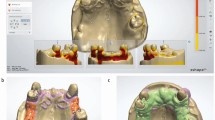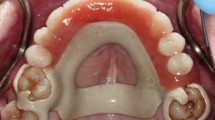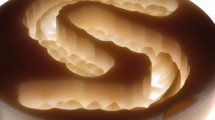Key Points
-
The recent introduction of the Medical Devices Directive has re-emphasised the need for clear prescriptions to dental technicians producing prostheses.
-
This article sets out the problems encountered, both clinically and technologically, and offers guidelines to both the clinician and technician in relation to the uses and design of special trays in fixed and removable prosthodontics.
-
Improving the clarity of communication between the clinic and laboratory could lead to more efficient use of chairside time, and also to an improvement in the quality of fixed and removable prostheses.
Abstract
This paper looks at how carefully prescribed special trays can be helpful in everyday dental practice. Guidelines are suggested for the design of custom trays, that will, hopefully, lead to improvements in the quality of working impressions.
Similar content being viewed by others
Main
The need to make accurate impressions is fundamental to the practice of prosthodontics.1 This requires the clinician to make a careful assessment of which tissues to include in the impression and also to consider how they should be recorded.2,3 In this paper we make suggestions as to how the careful design and construction of special trays may be used to enhance their clinical effectiveness, and thus help the clinician achieve the desired goal. The perceived need for such an article arose from many informal discussions with both technical and clinical colleagues. These discussions were followed by a pilot survey into the laboratory aspects of the prescription and design of special trays currently being requested from six commercial dental laboratories in the north of England. All the laboratories responded, and although the questionnaire was not designed to be strictly quantifiable, it nonetheless gave an interesting insight into the qualitative factors surrounding the use of custom trays.
The survey highlighted several key aspects related to the use of special trays:
-
Laboratories indicated the widespread use of special trays in the UK. This is in contrast to the previous survey of Basker4 et al., and it is postulated that this may be related to the presence of a specific fee available for the use of special trays in the NHS.
-
Most laboratories commented that they felt the need to modify the primary cast prior to special tray construction, usually to permit increased extension in the disto-lingual area of the lower molar region. This may indicate the inadequacy of many primary impressions to record this part of the mouth.
-
Special trays tended to be used in removable prosthodontics, with equal proportions being used in complete and partial denture cases. Custom trays were requested in only a small number of treatments involving fixed cases. This reflects the findings of others who have investigated the quality of impressions in fixed prosthodontics.
-
The majority of requests failed to specify the thickness of the spacer to be used in tray construction. This tends to delegate responsibility to the dental technician who is not trained to make this choice. Some comments were received which suggested that the technician knew the requirements of certain clinicians and they did not need to be specified. Although this might be the case for certain design features it is difficult to reconcile the fact that custom trays require the same amount of spacing for all cases.
-
Prescriptions rarely specified additional design features such as tissue stops, and the number and position of handles. The decision on which of these additional design features were appropriate was almost universally delegated to the technician. This ignores the potential for such features to have an influence on the quality of definitive impressions.
We hope that, through this article, practitioners will be encouraged to make modest changes to their current practice involving special trays. As a result they may begin to reap the rewards of reduced chairside time, together with the potential for improvement in the fit, and hence the quality of the prostheses they provide.
Removable prosthodontics
In removable prosthodontics, it is important that impressions record the whole of the potential denture-bearing tissues including any teeth involved in the design of the prosthesis. The clinician is thus faced with having to choose the most appropriate material to record the impression in addition to the type and design of tray used to carry the impression material of choice.
Conventional practice in removable prosthodontics indicates that it will usually be necessary to record a primary impression of the mouth using a stock tray. In essence the selected stock tray should cover the proposed denture-bearing area — to this end stock trays may be purchased in a variety of shapes and sizes (fig. 1). A variety of materials may be used to record the primary impression, for example impression compound or alginate used singly or in combination, to enable the clinician to achieve the main objective of the primary impression, which is to outline the denture-bearing areas. The cast obtained from the primary impression should then allow the fabrication of an appropriately designed customised (special) tray. The latter is used together with an appropriate impression material from a large range, for example alginate, zinc–oxide and eugenol (ZOE) paste, and the various elastomers depending on the specific clinical situation, to make the definitive or secondary impression. The master or working cast obtained from this impression is used as the basis for the reproduction of the fitting surface of the prosthesis, and therefore has a great influence on the retention, support and stability of any removable prosthesis.
The design of the custom tray will depend not only upon which material has been chosen for the definitive impression but also whether the dentist is attempting to record the tissues in a particular state of displacement. This will naturally depend on whether the tissues are to be recorded with a minimum of displacement ('mucostatic'), or if some degree of displacement of the soft tissues is intended to occur beneath the denture base ('mucodisplacive/mucocompressive').
Careful prescription of the design of the special tray by the clinician, and skilled execution of this design by the technician, can lead not only to significant savings in chairside time and effort, but can also improve the accuracy of master impressions, and hence the quality of the final prosthesis.
Fixed prosthodontics
The functional and aesthetic demands of bridge work means that fidelity in the impressions of the prepared teeth and surrounding teeth and soft tissues is essential. It will be necessary to record preparation details, together with any pontic areas and also include sufficient teeth as indicated by the need to record occlusal relationships. The use of impression trays in fixed prosthodontics has recently been studied by Winstanley et al.,5 who have shown that special trays are rarely used for the recording of preparations for crowns and bridges. This is most probably related to the widespread use of silicone putty-wash systems used in conjunction with a stock tray. The latter approach, when carefully applied, may be used to advantage. It is most likely to succeed in cases which involve short-span bridges, or those cases requiring only a modest number of crowns. Thus, although the demand for special trays in fixed prosthodontics would appear to be less than in removable cases, there is still a need to consider them in certain clinical situations. Special trays may be useful in recording impressions in fixed prosthodontics in the following circumstances:
-
When there is an unusual distribution of missing teeth
-
Where the arch form means that a stock tray is a poor fit. In these situations the impression material may be used in sub-optimal thickness, thus producing the potential to create inaccuracies
-
When the last tooth in the arch is to be included in the preparation. In these circumstances it is not uncommon to produce 'drags' in the impression when using stock trays
-
When impressions are to be recorded of teeth that exhibit significant mobility, as this will usually dictate the use of an impression material of very low viscosity in order to minimise displacement of the teeth. It is most unlikely that such a fluid material would be confined within a stock tray.
Design characteristics for special trays
It will become apparent that many features of design related to the use of special trays can have a bearing on the accuracy of definitive impressions. The dentist should consider the following key aspects of design when prescribing special trays in a given clinical situation:
-
The material from which the tray is to be made
-
The desired extension of the tray
-
The thickness of any spacer to be placed on the cast
-
The location of any tissue stops
-
The position, number and form of any handles.
Table 1 summarises a series of guidelines that may be followed in the use of custom impression trays in prosthodontics. These guidelines will now be considered in more detail:
Tray materials
Several materials are available for custom tray construction, including thermoplastic materials, self curing (and heat curing) polymethylmethacrylate resins, and the more recently introduced visible light cured (VLC) dimethacrylate resins. While all these materials may be used to yield satisfactory results, the thermoplastic materials exhibit lower strength and a lower elastic modulus compared with the resin materials, and this should be taken into account when making the prescription.
The VLC resin materials would appear to offer superior mechanical properties to the currently available alternatives.6 Trays made from this material have sufficient rigidity to be used in fairly thin section, and have excellent dimensional stability; they may also be immersed in the commonly used disinfectant solutions, for example 1,000 ppm sodium hypochlorite, without any significant changes in their physical or mechanical properties. They are quick and easy to fabricate, although the blanks of uncured material are relatively expensive compared with the other materials. In general terms they are less favourable in that they require a special light-curing unit for processing, they are also relatively hard when cured which makes them difficult to trim. Difficulties may also arise if the clinician elects to use an impression material with a high modulus of elasticity such as silicone putty or polyether. These materials are likely to cause distortion or fracture of the tray on removal from the mouth, especially in the presence of significant undercuts. The latter materials are perhaps better used together with a stock tray of sufficient rigidity, for example metal, rather than with a custom tray.
Tray extension
It is important to indicate this to the technician for two reasons: firstly, to ensure that the periphery of the tray does not distort the tissues of the sulcus through overextension; and secondly, to avoid the need to expend valuable chairside time trimming the tray to conform to the correct extension. The clinician is advised to indicate the desired periphery of the special tray by marking the impression. This may be readily achieved by marking the surface of the impression with a marking pen or pencil (fig. 2).
Spacer thickness
This is determined by the material to be used in making the definitive impression. It is an important specification as the impression material to be used then has an optimal even thickness to help improve dimensional accuracy, while also ensuring that the loaded tray is not too bulky, allowing ease of placement in the mouth. In addition, the special circumstances that sometimes occur in a given clinical situation may indicate that the supporting tissues are recorded in a particular state of displacement. The latter may then influence the amount of spacing to be used, together with the need for any perforations that help to prevent the build-up of hydrostatic pressure. The different thickness advocated for the spacing of the various impression materials are shown in Table 1.
Tissue stops
These allow the tray to locate in the mouth whilst maintaining the desired spacing for the impression material of choice. They are not essential in all cases, indeed they may not be particularly effective in some complete denture impressions owing to the compressibility of the supporting mucosa. They are valuable in fixed prosthodontics to act as locating stops when using fairly fluid impression materials. They should ideally be located at three widely spaced points around the arch, and placed with care to avoid including the teeth to be prepared.
Tray handles
Tray handles are particularly helpful when loading, placing and orientating custom trays in the mouth. They are also a potential source of inaccuracy, however, especially in impression-making for complete denture cases. This problem chiefly arises when the handle distorts the form of the lip and hence functional sulcus, or encourages the clinician to rest his fingers over the periphery of the tray, thus leading to an over-extended impression.
To overcome these problems practitioners are advised to specify a single handle positioned in the midline of the upper tray, which should be 'stepped' or angled to avoid interfering with the upper lip (fig. 3). For the lower tray three stub handles are suggested, positioned as follows: one in the midline, in the anterior region, together with one each side in the premolar regions. The latter may be used to support the tray while the material is setting, thus avoiding the possibility of the dentists fingers resting on the surface of the tray and distorting the recording of the peripheral form (fig. 4). In the special situation of the flabby upper anterior ridge, where the clinician elects to use a selective pressure impression, two handles should be positioned, one either side in the premolar/molar regions, thus avoiding the area of the tray that is to accommodate the 'open window' (fig. 5).
Conclusion
The survey indicates the widespread use of special trays in the UK, especially for the production of removable prostheses. The fact that these trays are used in such large numbers is to be welcomed. However, despite the frequent use of custom trays few clinicians appear to specify the design details to be used in their construction. To obtain maximum benefit from the use of custom trays, clinicians are encouraged to become more prescriptive in their design characteristics. The key areas to be addressed in making prescriptions for special trays are to have both common and specific themes depending on the clinical situation, and the type of prosthesis to be provided. These have been described in some detail, and guidelines have been given to help the practitioner faced with making a prescription. Improving the prescription for special trays should lead not only to more efficient use of chairside time but also to an improved quality of definitive impressions, and hence final prostheses.
References
Hickey J C, Zarb G A, Bolender C L . Bouchers Prosthodontic Treatment for Edentulous patients. 9th ed. 119–230. St. Louis: CV Mosby Company, 1985.
Grant A A, Heath J R, McCord J F . Complete Prosthodontics. 89–93. London: Mosby-Year Book Europe Limited, 1992.
Guide to standards in prosthetic dentistry. A report by the British Society for the Study of Prosthetic Dentistry. Br Dent J 1981; 150: 167–169.
Basker R M, Ogden A R, Ralph J P . Complete denture prescription — an audit of performance. Br Dent J 1993; 174: 278–284.
Winstanley R B, Carrote P V, Johnston A . The quality of impressions for crowns and bridges received at commercial dental laboratories. Br Dent J 1997; 183: 209–213.
Devlin H, Cash A J, Watts D C . Mechanical behaviour and structure of light-cured special tray materials. J Dent 1995; 23: 255–259.
Author information
Authors and Affiliations
Additional information
Refereed Paper
Rights and permissions
About this article
Cite this article
Smith, P., Richmond, R. & McCord, J. The design and use of special trays in prosthodontics: guidelines to improve clinical effectiveness. Br Dent J 187, 423–426 (1999). https://doi.org/10.1038/sj.bdj.4800295
Received:
Accepted:
Published:
Issue Date:
DOI: https://doi.org/10.1038/sj.bdj.4800295
This article is cited by
-
Variations in tooth preparations for resin-bonded all-ceramic crowns in general dental practice
British Dental Journal (2001)









